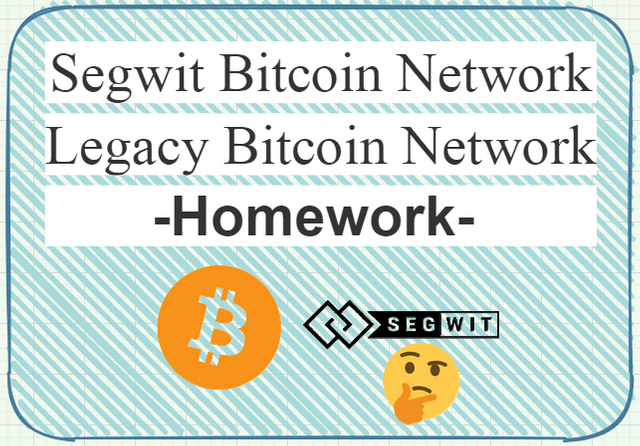Hi Steemains,
Today I am going to write an article about the bitcoin network and its Segwit upgrade, as part of the homework requested by professor @gbenga during the third week, I wish you a good read and don't hesitate to leave me comments if you have any questions.

Introduction :
Again and again, people who are using their Ledger hardware wallet for the first time, ask themselves the question, "What address format should I choose for my Bitcoin account? For example “Legacy”, “SegWit” or even “Native SegWit”? ”. Since there are now three different formats, you can quickly think about the differences, advantages and disadvantages. This article will help you get a good overview.
Legacy address format (P2PKH)
P2PKH, called Legacy Format, was the first and original form of Bitcoin addresses and stands for “Pay-to-Public-Key-Hash”, that is, payment to a hash of the recipient's public key.
You can recognize an old Bitcoin address by the fact that it always begins with the number "1".
For example,
Payments from P2PKH format addresses generally consume more storage space as they are not compatible with a transaction format change / enhancement that was activated in August 2017. This makes the use of old addresses more expensive, because more storage space used also means higher costs.
The SegWit (P2SH) format
SegWit stands for "separate cookie" (partly "externalized cookie") and is actually not an address format at all, but the improvement of the Bitcoin protocol mentioned above, which reduces the size required to store transactions in a block. The fact that the so-called signature data has been deleted or exchanged in SegWit transactions means that the space can be used more efficiently. By making transactions smaller / lighter, more transactions fit into a block. This makes the Bitcoin network more scalable and its transactions faster. Plus, it dramatically reduces transaction fees for every Bitcoin transaction!
SegWit was first introduced via the “Pay-to-Script-Hash” (P2SH) format. The peculiarity of P2SH is that the sender no longer sends the BTC to the hash of a recipient's public key, but the recipient sets certain rules (the so-called "script") that determine how the received coins can be spent . The sender can now send the BTC to a hash of this script, and the recipient can only output the BTC if they submit the original script for this hash.
Colloquially, P2SH addresses are referred to as "SegWit" (sometimes also "nested SegWit") addresses, although these of course also allow other scripts. For example, multi-signature transactions, that is, transactions in which not only one but several parties must sign.
You can recognize SegWit addresses by the fact that they basically have the same format as legacy addresses, but unlike legacy addresses, they always start with the number "3".
The native SegWit format (Bech32)
Since using SegWit in P2SH format is actually just a workaround to ensure compatibility with older wallets, an address format was not introduced until a short time later, which SegWit implements. natively.
The advantages of SegWit only come into their own in the so-called Bech32 format, which means that payments from a Bech32 address are again significantly cheaper and faster. Another advantage of these addresses is that they all start with "bc1" and consist exclusively of lowercase letters, which greatly reduces readability and the risk of typing errors.
Example of Bech32 address:
Which address should you use?
Due to the advantages of the Bech32 format, using Native SegWit is fundamentally the smartest because it is the most cost effective and efficient solution. Unfortunately, some exchanges still do not support bc1 addresses and it could be that these are not recognized as Bitcoin addresses and therefore the exchange refuses to pay you. However, if you are signed up for such an exchange, there is a solution:
- Create a second address in a different format in your wallet.
- Make your Bitcoin pay at this secondary address.
- Send the bitcoin to your bc1 address if necessary.
- Delete the account during this exchange.
Conclusion:
Thus, SegWit is an upgrade of the Bitcoin protocol bringing its share of improvements. In particular, it corrects the transaction malleability problem that made it difficult to implement the Lightning network and increases the capacity of the network. The fact that it is a soft fork makes SegWit compatible with older versions of Bitcoin, but SegWit is far from perfect: it suffers from major flaws that compensate for this backward compatibility, such as its technical debt, which is substantial. .

Cc:-
@steemitblog
@steemcurator01
@steemcurator02
@gbenga







This is quite an interesting contribution, thanks for participating in this week's task.
Question: If you were to make an upgrade to the Bitcoin network without tampering with the blockchain, what would it be?
Rating 8/10
Downvoting a post can decrease pending rewards and make it less visible. Common reasons:
Submit
From what I read it will be the Lightning Network which is an ingenious solution to the Bitcoin scalability problem and has definite advantages:
Downvoting a post can decrease pending rewards and make it less visible. Common reasons:
Submit
Twitter Promotion
Downvoting a post can decrease pending rewards and make it less visible. Common reasons:
Submit